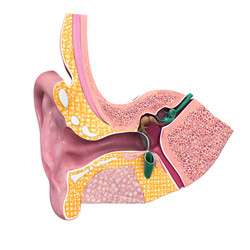The three-year EU-funded HEAR-EU project, which was completed at the end of August 2015, has pioneered ground-breaking imaging technology and surgical planning software to improve the likelihood of successful cochlear implant surgery.
The project's new high-energy micro CT scanner prototype is now running and the intention is to soon bring the innovation to market. Based on improved images from this scanner, high-resolution cochlear models that show the range of variation in patients can be combined with standard clinical images, giving medical professionals a better understanding of each individual patient's needs. This will help them to choose the best implant model – and position of each implant – in relation to a patient's anatomy.
New computational tools have also been developed to help surgeons achieve safe drilling trajectories to the cochlea along with a combination of metrics designed to evaluate the likelihood of trauma.
'HEAR-EU will help define and design a new generation of cochlear implants (CI) with optimal functional performance,' says project coordinator Professor Miguel A. González Ballester from ICREA and Universitat Pompeu Fabra in Barcelona. 'This will significantly improve patient's quality of life into older age and will also improve the life expectations of very young children by allowing for more efficient CI implantation at a very early age.'
The innovation also has the potential to cut European healthcare costs by reducing hospitalisation and operation times regarding CI surgery. 'This will be achieved by making available these new computerised surgical planning and diagnostic tools,' adds González Ballester. 'HEAR-EU also contributes to promoting the position of European industry in the EU and worldwide market of products and services associated with medical technologies. Furthermore, due to the complexity of the surgical procedure, novel technologies such as computer assisted planning could greatly benefit the training of young surgeons.'
Cochlear implantation aims to overcome hearing loss by direct electrical stimulation of the spiral ganglion cells in the cochlea of the inner ear. Technological progress in this area has led to the development of inner ear implantable devices, which have proved to be of great benefit to patients suffering from moderate to severe hearing loss.
'Implantation surgery is however very complex,' says González Ballester. 'It requires a high level of clinical expertise in order to efficiently access the surgical site – the cochlea – localise nearby critical structures (such as facial nerves) and optimise the position of the implantable device (the electrode array) inside the cochlea.'
Patients also come in all shapes and sizes, making individual optimal fitting an extremely difficult task. The length of the cochlear duct for example can vary between 25 and 35 mm. It is crucial therefore that anatomical variability is considered not only during the surgical planning process, but also in the design phase of implants.
'Overall, the project has produced very important advances both theoretically and technically,' says González Ballester. 'The consortium is proud that all the project objectives have been achieved. Significant improvement in cochlear implant output is expected, even under more difficult hearing conditions.'
The project results will be used to help plan interventions and optimise the design of future generations of CI electrode arrays that fully take into consideration individual patient requirements.
More information: For further information please visit HEAR-EU project website: www.hear-eu.eu/
Provided by CORDIS




















